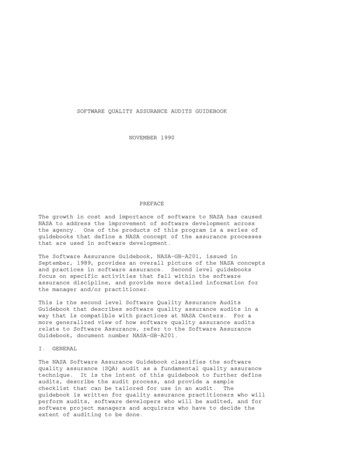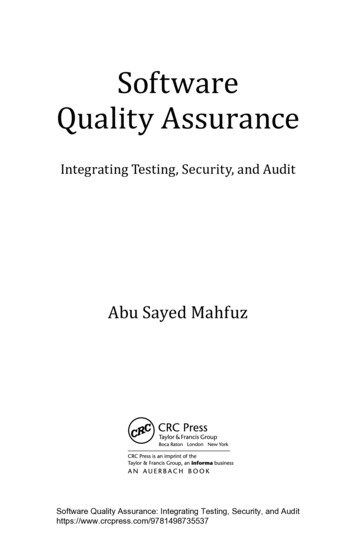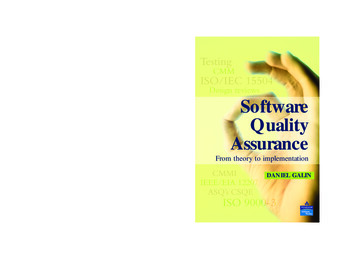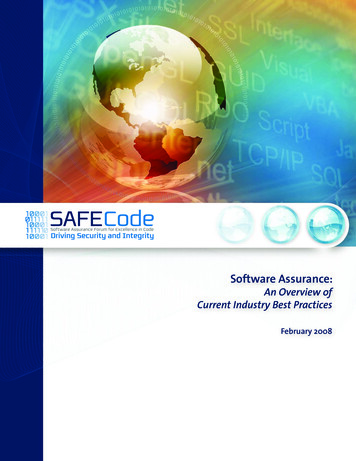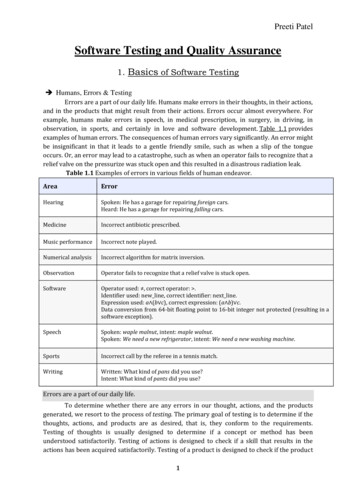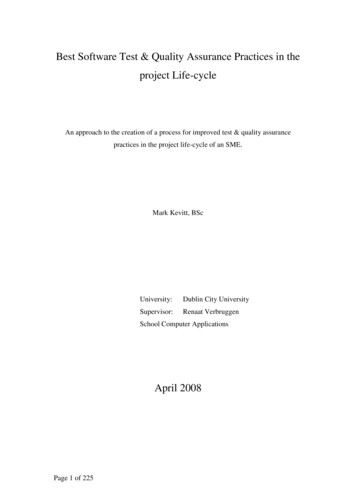
Transcription
Best Software Test & Quality Assurance Practices in theproject Life-cycleAn approach to the creation of a process for improved test & quality assurancepractices in the project life-cycle of an SME.Mark Kevitt, BScUniversity:Dublin City UniversitySupervisor:Renaat VerbruggenSchool Computer ApplicationsApril 2008Page 1 of 225
AbstractThe cost of software problems or errors is a significant problem to global industry, notonly to the producers of the software but also to their customers and end users of thesoftware.There is a cost associated with the lack of quality of software to companies whopurchase a software product and also to the companies who produce the same piece ofsoftware. The task of improving quality on a limited cost base is a difficult one.The foundation of this thesis lies with the difficult task of evaluating software from itsinception through its development until its testing and subsequent release. The focusof this thesis is on the improvement of the testing & quality assurance task in an IrishSME company with software quality problems but with a limited budget.Testing practices and quality assurance methods are outlined in the thesis explainingwhat was used during the software quality improvement process in the company.Projects conducted in the company are used for the research in the thesis. Followingthe quality improvement process in the company a framework for improving softwarequality was produced and subsequently used and evaluated in another company.Page 2 of 225
Table of contents12345Chapter One – Introduction . 51.1A software company with software quality problems . 5Aim . 5Objectives . 6Chapter Two - Methodology. 72.1Action Research . 72.2The type of Action research used in this thesis. 9Chapter Three - What is software testing . 113.1.1Principles of software testing . 113.2Principal testing methods . 123.2.1Functional testing (black box) . 123.2.2Structural testing (white box). 143.2.3Grey box testing . 153.2.4Thread Testing . 163.2.5System Testing . 173.3The Test Process . 203.3.1Test Planning . 213.3.2Manage Test Execution. 243.4Summary . 35Chapter Four – Quality Assurance . 374.1Complications with software and its quality assurance . 374.1.1Factors that impact Software Quality . 394.2Software Quality Assurance . 434.2.1Verification versus Validation . 454.3Software Quality measurement . 464.3.1Software Defects . 484.3.2Classification of Software Errors . 494.4Structure of Software Quality Assurance (SQA) . 524.4.1Planning from the project initiation and project planning stage . 534.4.2Management of the Project life-cycle activities and components . 574.4.3Defect Prevention process. 654.4.4Capturing and analysing defect metrics . 674.4.5Quality Management Models . 724.4.6In process metrics for software testing . 744.5Refactoring the Management of all SQA components . 774.5.1Software Quality Management . 774.5.2The SEI Process Capability Maturity model . 794.5.3Software Process Assessment . 814.5.4Software Quality Auditing . 834.6Summary . 84Chapter Five – Software Test and Quality Assurance Practice Improvement . 855.1The first steps to test and QA practice improvements . 855.1.1Industry background . 865.1.2Description of company X BMS system . 875.1.3Research and Development department description . 905.2The Quality problem that is to be tackled . 935.2.1The investigation . 945.2.2The investigation findings. 95Page 3 of 225
67895.2.3The proposal to the company . 1055.3My proposed solution . 1065.3.1The Principal design factors behind my proposed solution . 1065.3.2An Initial model . 1095.4Summary . 114Chapter Six - Implementation of improvements . 1156.1Company X - HVAC Controller Project . 1176.1.1HVAC Project description . 1176.1.2HVAC Plan . 1186.1.3HVAC Project Implementation (Execution and Observation) . 1276.1.4HVAC controller project reflection . 1346.2Company X CNET Project Repeat improvements . 1366.2.1CNET Project description . 1366.2.2CNET Plan . 1376.2.3CNET Project Implementation (Execution and Observation) . 1396.2.4CNET Controller Project Reflection . 1426.3Company X – UEC8 Engineering Application . 1446.3.1UEC8 Project description . 1446.3.2UEC8 Plan . 1456.3.3UEC8 Project Implementation (Execution and Observation) . 1466.3.4UEC8 project reflection . 149Chapter Seven - Development of a Framework . 1517.1Evolved quality assurance framework . 1547.2Secondary Independent Assessment of my proposed Solution . 1607.3Company Y - Project FIIS Application . 1627.3.1FIIS Project description . 1627.3.2FIIS Plan . 1637.3.3FIIS Project Implementation (Execution and Observation). 1667.3.4FIIS project reflection . 1697.4Summary . 170Chapter Eight - Conclusions and Further work . 1718.1Conclusion . 1718.1.1Limitations of research . 1738.1.2Improvements to practices . 1748.2Further Work . 175Appendices, Glossary and Bibliographies . 1769.1Appendix A Company X process documentation . 1769.2Appendix B – Glossary of terms . 1779.3Bibliography . 1799.4Web Bibliography . 180Page 4 of 225
1 Chapter One – Introduction1.1 A software company with software quality problemsThis thesis is focused on the creation and provision of a testing & quality assurance(QA) process for software quality improvement in an Irish company (the company)and also for the creation of a framework for similar quality improvements in theprocess for other company‟s.Employed in the company as a testing professional I have the responsibility to lead atest department and to ensure that the software released to the customers is of thehighest standard. To raise the bar on this standard I decided to conduct research intotesting and QA practices and to implement improved practices within the company.This thesis is a product of the research into test and QA practices and for the provisionof an improved test process in the company. This process will combine elements oftesting and QA into one process, this one process in turn will be inserted into thecompany‟s development lifecycle.The research was agreed with academic representatives from DCU University andwith senior management from the company. I conducted this research on a part timebasis with the University while working full time in the company.AimThe aim of this thesis is to investigate the best test and QA practices in industry and todesign and evaluate a process for implementing best practices in the software lifecycleof a small to medium enterprise (SME) over successive projects.Page 5 of 225
ObjectivesThere are a number of objectives for this paper, the first is to define the principles ofsoftware testing, describe the numerous testing methodologies and how to effectivelyconduct this testing on projects in industry. This is covered in the third chapter.The second objective is to evaluate what constitutes software quality and what factorsaffect this quality and how, when and where QA can be used in the project life-cyclefor improving product quality. This is covered in the fourth chapter.The third objective is to outline the test and QA effort during a project in a particularcompany and to evaluate the adoption of improved practices during subsequentprojects in the same company. These two topics are covered in the fifth and sixthchapters respectively.The fourth objective is to develop the improved practices into a framework forevaluation in other company‟s. This is covered in the seventh chapter.Page 6 of 225
2 Chapter Two - Methodology2.1 Action ResearchThe research methodology that was chosen for this project is action research. Actionresearch is a methodology which has the dual aims of action and research. The actionis to bring about change in some community or organisation, and the form of researchintended to have both action and research outcomes. The purpose of action research isto learn from your experience, and apply that learning to bringing about change. “Thetask of the practitioner researcher is to provide leadership and direction to otherparticipants or stakeholders in the research process” (Ernest Stringer. 1996)Action research in the organisation (David Coughlan et al. 2005)1. Review current practice2. Identify an aspect that needs improvement3. Plan an action4. Act it out5. Evaluate the result6. Re-plan an additional cycle7. Continue until completePage 7 of 225
Examples of Action ResearchAction Research, as described by Lewin, proceeds in a spiral of steps composed ofplanning, action and an evaluation of the result of the action.Figure 2.1. The Action Research spiral model.The advantages of action research are that it lends itself to use in work or communitysituations. Practitioners, people who work as agents of change, can use it as part oftheir normal activities. This means that in the course of researching best practices insoftware quality improvements, it can also be applied during the operation of anorganisation.The disadvantages to action research are that it is harder to do than conventionalresearch. There is a dual role of the researcher to conduct research but also to makechanges and record the results of these changes.Page 8 of 225
2.2 The type of Action research used in this thesisHolter and Schwartz-Barcott (1993:301) discuss three types of action research, that ofa technical collaborative approach, a mutual collaborative approach and anenhancement approach. McKernan (1991:16 -27) lists three types of action research,the three fall roughly into the same categories.The type of action research that has been chosen for this thesis is that of type I,Technical/Technical-Collaborative. The reason behind this choice is that it closelymatches the aims for the thesis. The research includes process improvement and thederivation of a framework for best test and QA practices and to evaluate thisframework in a real software project life-cycle.Type 1: Technical/Technical-Collaborative(McKernan 1991:16) The underlying goal of the researcher in this approach is to testa particular intervention based on a pre-specified theoretical framework, the nature ofthe collaboration between the researcher and the practitioner is technical andfacilitatory.Technical action research promotes more efficient and effective practice. It is productdirected but promotes personal participation by practitioners in the process ofimprovement.Data Collection MethodsTwo different data collection methods will be implemented to conduct the research.Both quantitative and qualitative styles are applied to corroborate the data collected.A quantitative experimentation will be the primary method. This will providestatistical data for evaluating the effectiveness of the test & QA practices.Page 9 of 225
The data will be in the format of the time to complete the project and the cause of anydelays if any, the number of test cycles that had to be run and the number of defectsfound during the testing of the project and their severity. In order to reduce theinfluences of external dependent variables a secondary technique of interviewing willbe conducted.PopulationFor this thesis the population will be the employed developers, testers, technicalsupport engineers and managers of the projects in which the experiments are beingconducted.Page 10 of 225
3 Chapter Three - What is software testing3.1.1 Principles of software testingThe purpose of software testing is to detect errors in the software. The tester shouldideally detect all errors before the software is released to the customer. Full testcoverage of a program is impossible. “Proving that a program is fault free isequivalent to the famous halting problem of computer science, which is known to beimpossible” (Paul C. Jorgensen. 1995The main principle of software testing “is the process of executing a program with theintent of finding errors”. (Glenford J. Myers, 2004). To test the program morethoroughly a tester would need to evaluate the program to detect both types of errors.This principle is thus more detailed to “Test the program to see if it does what it issupposed to and to see if it does what it is not supposed to do”. (Glenford J. Myers,2004)In order for the tester to find these errors, he will devise a number of tests to executeon the software itself. Theses tests must be based on prior knowledge of the software.The two main thrusts of testing are firstly based on the composition of the software,i.e. its internal structure. Secondly based on the business or intended purpose of thesoftware, i.e. the functional aspect of the software.Based on one of these box test paradigms the tester will write a series of tests (testcases) to detect any errors and to evaluate if the outcome of the test meets with thesoftware design. “Invalid and unexpected input data are more effective at detectingerrors than valid and expected data” (Glenford J. Myers, 2004). The problem here isdetermining whether or not the results of the tests are errors or actual expected results.Where errors are detected, it is prudent to test this area of the program in more detailas statistically more errors will be present in this area “The probability of theexistence of more errors in a section of a program is proportional to the number oferrors already found in that section” (Glenford J. Myers, 2004).Page 11 of 225
3.2 Principal testing methods3.2.1 Functional testing (black box)Functional testing is “testing that ignores the internal mechanism of a system orcomponent and focuses solely on the outputs generated in response to selected inputsand execution conditions” (Jerry Zeyu Gao et al, 2003). Functional testing is directedat executing test cases on the functional requirements of software to determine if theresults are acceptable.“The use of equivalence classes as the basis for functional testing has twomotivations: we would like to have the sense of complete testing, and at the sametime, we would hope that we are avoiding redundancy” (Paul C Jorgensen. 1995)The method for equivalence classes / partitioning uses two rules:1. A test case must reduce by more than 1 the number of other test cases that must bedeveloped to achieve some predefined goal of reasonable testing.2. It covers a large set of other possible test cases, i.e. it tells us something about thepresence or absence of errors over and above this specific set of input values.(Glenford J. Myers, 2004).The second consideration is used to develop a set of challenging conditions to betested. The first consideration is then used to develop a minimal set of test casescovering these conditions.“For the partition testing, input domain will be classified into different disjointedpartitions. Ideally, every element in each partition has the same possibility to eitherreveal or hide a fault. But based on programming experiences, this is usually not true.Values that are close to the boundary of the partition are more likely to expose errors”(Jerry Zeyu Gao et al, 2003).Boundary value analysis explores test situations on and around the edges ofequivalence classes. The conditions are those situations directly on, above and belowPage 12 of 225
the edges of input equivalence classes. The two differences between Equivalentpartitioning and boundary analysis are:1. Boundary value analysis requires that each edge requires a test case, equivalenceclasses uses one input as one test case.2. The test cases in boundary analysis require the output space to be considered alsofor test cases. The output space of equivalence classes are not considered as testcases.Typically, a few rules of thumb can be applied so that both equivalent partitioning andboundary analysis can both be applied for test cases that are more comprehensive. Theedges that are referred to are generally the upper and lower values permitted by anapplications input such as the first and last months of the year. The output domainmust also be considered so that the expected output is achieved and also to exploreeach alternative unexpected output.If an input condition requires a minimum and maximum range such as that above then use the validmonths 1 & 12, also use the invalid months of 0 and 13.If an input condition specifies a range of values permitted such as between -1000.0 and 1000.0 thenuse -1000.1, -1000.0, 0, 1000.0 and 1000.1.If the output domain expects to calculate a person‟s age based on the input date of birth and the currentdate then attempt to generate additional invalid output domains such as a 0 age, a negative age and anage in excess of the maximum, 200 years old for example.If the output domain expects more than one output, for example a date of birth, a current age and aretirement age. Then generate an output domain with 0,1,2,3 and 4 valid and invalid output domains.Fig 3.1 boundary value analysis examples.A competent tester will however have the traits of wanting to excel at breaking anapplication in the most unexpected manner and with increased experience will morethan likely be able to create additional test cases to accomplish just this. Errorguessing is “is likened to a natural intuition or skill to determine how things work andhow best to break them” (Glenford J. Myers, 2004) these additional error guessingtest cases can unearth the most unexpected outcomes from systems.Page 13 of 225
3.2.2 Structural testing (white box)There are two benefits of structural testing; the first is the creation of test cases basedon the logic of the application. The second is the detection of how successful tests areby examining how many different paths through a program were executed.“In path testing, a major difficulty is that there are too many feasible paths in aprogram. Path-testing techniques use only structural information to derive a finitesubset of those paths, and often it is very difficult to derive an effective subset ofpaths” (Jerry Zeyu GAO et al, 2003)The use of test cases based on the logic of programs would require a map of thenodes and connecting paths. You would also need equivalent methodologies todetermine what test cases to create or to determine by some metrics how successfulthe test cases were. To test and evaluate the program the tester should select test dataso that each path is covered at least once. This does not guarantee that all errors willbe detected since there may be a substantially large number of paths in the programslogic. As each decision on a path has a subsequent decision on the same path themagnitude of nodes and different paths increases from 22 to 2n where n is the numberof different paths through the code. To increase the rate of error detection a number ofmetrics can be calculated to evaluate just how successful test cases are. Statement coverage Decision Coverage Condition Coverage Decision-condition coverageThe complexity of the logic is determined by the number of different nodes and thenumber of different possible paths through the application. The use of the abovemetrics would enable the tester to determine how much of the code has beenexecuted. The test case results demonstrate the likelihood of the future success of theapplication.Page 14 of 225
3.2.3 Grey box testingGrey box testing is a blend of white and black box testing. In order to conduct whitebox testing the code needs to be analysed and the paths through the logic mapped out.This is a time consuming and expensive process which would typically require toolsupport. It would be conducted in the more mission critical software systems such asaeronautics, automotive and other mission critical systems. Not all software houseshave such tools or the time or need to go to such depths for analysing the code.However ignoring structural testing and only conducting functional tests would leavea large percentage of defects unnoticed until the system goes live. To circumvent thisgrey box testing is used.The design or architecture of the system would be used to map out the logic of certaincomponents in the system. The developers themselves would typically also be askedfor input into how certain modules were coded. This information is invaluable inassisting the tester design intuitive positive and negative tests for the system. Test datacould also be created that would give best coverage of the system.The data flow and business organisation of the application under test would alsogreatly assist the tester to ensure that the test cases adequately cover all of thefunctionality. The design of use cases that depict user scenarios help the tester toappreciate the important business rules and to focus on these. The flow of data duringthe business functionality is also critical for testing. “Use cases capture the system‟sfunctional requirements from the user‟s perspective; they also serve as the foundationfor developing system test cases”. (William. E. Lewis. 2005)Page 15 of 225
3.2.4 Thread Testing“An approach most suitable for real-time systems is that of thread testing. Thesystem is segmented into threads where software test and construction areinterwoven. The modules associated with each thread are coded and tested in theorder that is defined within the schedule. Integrating the builds will eventuallyconstruct the entire system”. (De Millo et al. 1987).The feasibility of thread testing is dependent on a sequential development process.In a scheduled sequence the builds of software should deliver a certain componentof functionality. The testing is conducted on each successive build or thread, eachthread if successful is then integrated into the entire system. The test process isintertwined with the development process more closely than with otherapproaches. The most critical threads should be developed and tested first. Theschedule for both development and test would overlap on the same componentswith development having a certain amount of lead time. A good visualrepresentation would be a staggered production line, where certain componentsare assembled in a predefined order with one side of the line assembling thecomponents with the opposite member conducting quality control checks. By thetime that the product reaches the end of the line it should be fully complete andapproved by YXZYZFig 3.2 Example schedule for thread testing with 3 threads X, Y, and ZPage 16 of 225
3.2.5 System TestingSubsequent to integration testing a complete system or application has beendeveloped with working interfaces. This does not mean that the system is necessarilycomplete. In order to be satisfied that a system is both entirely complete and correct,you would need to be confident that all of its intended functionality exists and that itperforms each correctly under every foreseeable circumstance that is possible duringits operation. System testing is an attempt to demonstrate if the program as a wholedoes meet its stated objective.System testing is non trivial and is therefore broken down into many different testtypes, sometimes referred to as higher order tests. Each of the higher order teststargets a particular domain of the system. These domains are likely problem areas thatcould potentially prevent the system performing some of its intended purpose. Systemtesting as its name suggests, means that each of the elected higher order tests areexecuted on the system as a whole.It is advantageous for an independent team to perform the system testing includingsome end users, a representative of the development team and of course the testerswho have to know the system in its entirety and the target audience.“When you finish module-testing a program, you have really only just begun thetesting process. This is especially true of large or complex programs. To completetesting, then some form of further testing is necessary. We call this new form higherorder testing. The need for higher-order testing increases as the size of the programincreases. The reason is that the ratio of design errors to coding errors is considerablyhigher in large programs than in small programs.” (Glenford J. Myers, 2004).Page 17 of 225
The main higher order tests are listed and 2 relevant for this thesis are outlined below:Performance testingLoad/Volume testingStress testingSecurity testingCompatibility testingConversion TestingBackup testingRecovery testingInstallation testingReliability testingUsability testingAcceptance testingFunctional TestingFig 3.3 Higher order system testsTwo system tests that are pertinent to this thesis are explained below in more detail.Usability TestsThe objective of usability testing is to determine how well the user will be able to use,understand and navigate through the application. If the system has a UI that isseparate from the main thru
1.1 A software company with software quality problems This thesis is focused on the creation and provision of a testing & quality assurance (QA) process for software quality improvement in an Irish company (the company) and also for the creation of a framework for similar quality

